#topological crochet
Text

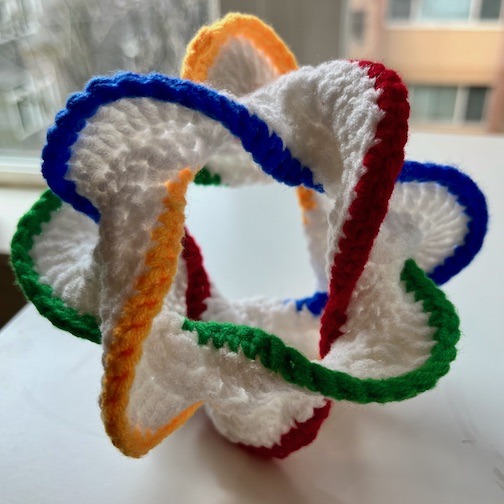
A surface bounded by four interlocking "triangular" loops, made with Shiying Dong's seamless topological crochet method
3K notes
·
View notes
Text
Unlock the Magic of Mobius Crochet: Your Ultimate Step-by-Step Guide
Discover the enchanting world of Mobius crochet with our detailed video tutorial! Learn how to master the half-twist crochet chain technique and create stunning one-sided wonders. Perfect for both beginners and experienced crocheters, this guide will help you craft stylish scarves, trendy hats, and show-stopping shawls. Elevate your crochet skills and join the Mobius crochet revolution today!
Watch the full tutorial on YouTube: Master the Art of Mobius Crochet
#strawberrycouture#crochet#mobius#fiber arts#fibre arts#yarn#fibre crafts#video#math#Loki#lokius#Mobius#Mobius m Mobius#mathematics#topology#creative inspiration#creative process#youtube video#craft#instructions
0 notes
Text
if you knit or crochet you need to know math. "oh, because you have to count the stitches?" you'd think so wouldn't you. well it's actually because sometimes the yarn gets so messed up you can't untangle it without becoming an expert in the field of topology
6K notes
·
View notes
Note
do you think wei ying could be a knitter? or lan zhan?
This ask will haunt me because I KNOW this was discussed between me and the twitter mutuals back in the day, and i KNOW we came down hard on a take. I suspect both of them could, but Wei Ying would only do it in order to solve a problem (no gloves, experimental archeology, needs to better picture something in cosmic topology and crochet can create weird non-Euclidean shapes, lost gloves again), while Lan Zhan might just like it.
#ask replies#anon ask replies#mdzs#i'm assuming this is modern au based on the current known history of knitting
10 notes
·
View notes
Text
a math museum gives fancy crochet classes but they are too late for me due to timezone😭
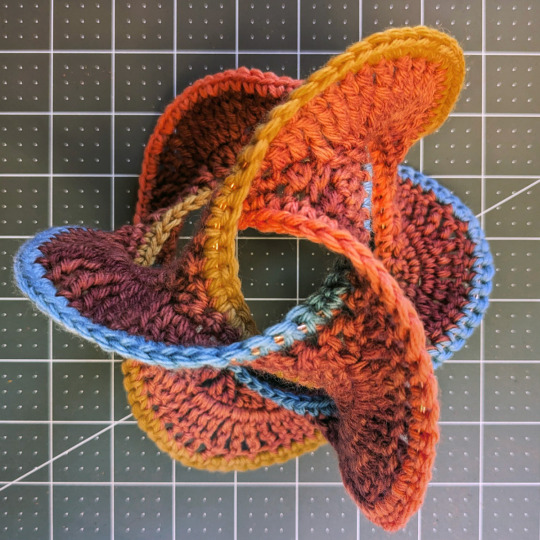
and with a membership one can view all old videos and they taunt me with tax deducability but i cannot deduct any money given into the us like this afaik
otherwise i just have to pay for the videos
8 notes
·
View notes
Text
just got an email from momath inviting me to a topological crochet event in person and I've never wanted to be in new york more than that
#momath is the math museum in ny that focuses on math communication and outreach and they have a lot of cool things#i am subscribed to their newsletter so that's why i got the email bc they do events that are also over zoom and all that#or are hybrid but this one is exclusively in person and i never had any interest in new york until now#🐌
8 notes
·
View notes
Quote
Are you a topologist who’s keen to make an interesting mapping cylinder, a geometer who likes to see a beautiful surface spanning in space, a polyhedra worshipper, a knotter tyer who would love to expand your portfolio? Maybe you are a crocheter in search of a novelty project, or a fan of Bathsheba Grossman, Charles Perry, and Brent Collins and would love to make small models of their work by yourself? If you answered “yes” to any of those questions, or if you just want to crochet some interesting and beautiful mathematical surfaces, topological crochet is perfect for you!
Online Topological Crochet – National Museum of Mathematics
0 notes
Text
crochet patterns itch my brain so good because its like the exact same thing as 3d topology. like im like making the intj face imagining the wireframe overlaid on pictures of crochet amigurumis like yes..... trivial..........
0 notes
Text
Non-Woven structures introduction post
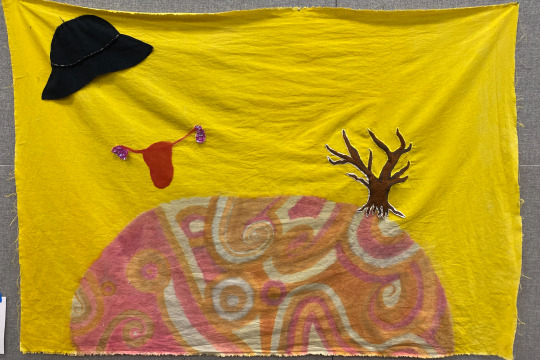
"Unwanted theft", Final studio project in Fall 2022 in fabric surface design. I was influenced by the artist research of Lavanya Mani. She uses the traditional Indian fabric design of Kalamkari in a modern way that provides social commentary on relevant issues that plague our society. Using this foundation, I built upon this by using the same kalamkari process, that involves natural fabric processing and the exclusive use of natural dyes. I am the most proud of this work, I dedicated a lot of time and effort into it and was very happy with the result. My design strives to show the importance of reproductive rights on our society. Women's health has been neglected within our society, with certain important rights being taken away or restricted. Specifically, I wanted to show the detrimental effects that result from rights being revoked. Here, there is a colorful planet, a dark force from above is taking away a uterus from the planet on one side, but on the other there is dead tree that emerges from the planet. Symbolizing that by taking away basic reproductive rights, the happiness and colorfulness that remain within society are shifting to more barren world.

Made with pens and paper.


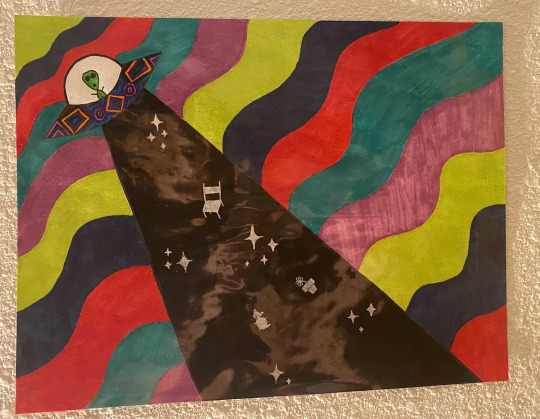

I made these together this past summer. They are also pen or sharpie on printer paper. I did laminate them to preserve their integrity. These are all different space landscapes.


Repost from last semester but I am very satisfied with my crochet bag. I also made this, this past summer. I did replace the button with a bigger, more functional button. This one was too small so the button loop that I stitched would not stay on the small button since the loop was too big. The bigger button works much better, and thus the bag remains secure.
An artist that I am interested in right now is Rafael Lozano-Hemmer
I saw an exhibition of his at SuperBlue in Miami over the most recent winter break.
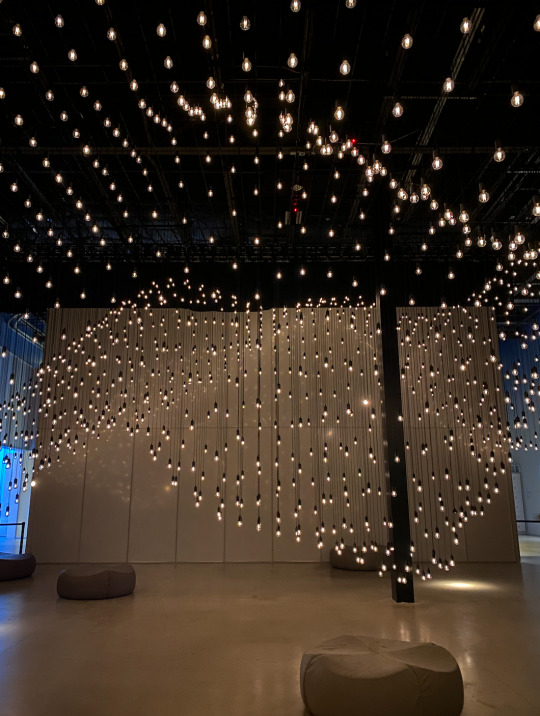


This installation was composed of 3,000 light bulbs that formed in crests and valleys and three pulse sensors. Titled, pulse topology. Topology is the study of geometric properties and spatial relations that are not affected by a change in shape or size of an object. So, a geometric object is preserved under continuous deformation.
Pulses are translated into a sound and light that is reflected in one of the 3,000 light bulbs in real time and added as a recording. Each bulb flickers at a different rate since each stores different data based on the most recent pulse readings. Therefore the new readings replace the older ones for upto 3,000 at one time.
Bulbs in action!!
0 notes
Text
I JUST INVENTED THE GREATEST FIDGET TOY IN HUMAN HISTORY
I CROCHETED A MÖBIUS STRIP
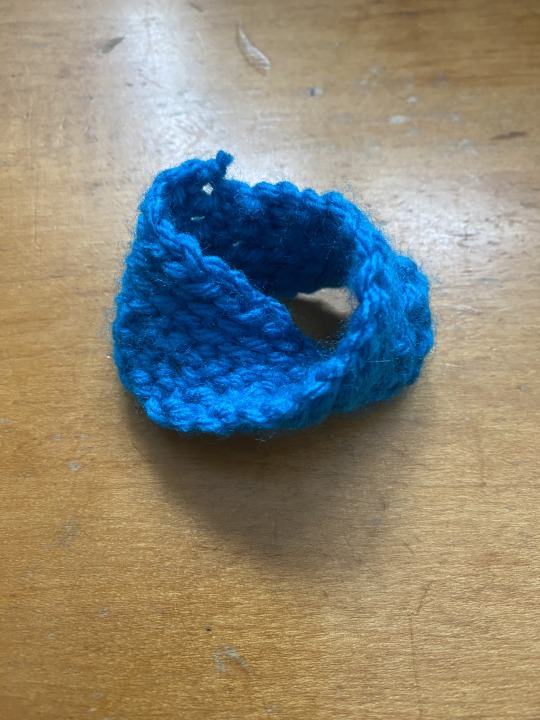
soft, silent, fidgety heaven. just crochet a chain, make it a circle, and then when you go to spiral around to make a normal tube, just frick it up by putting a twist into it and then continue as normal and you'll find yourself building this adorable little freak of topology <3
#squido's op#adhd#actually adhd#stim#fidget toys#mobius strip#crochet#no clue how to tag this but it's cool you guys
71 notes
·
View notes
Text
topological crochet
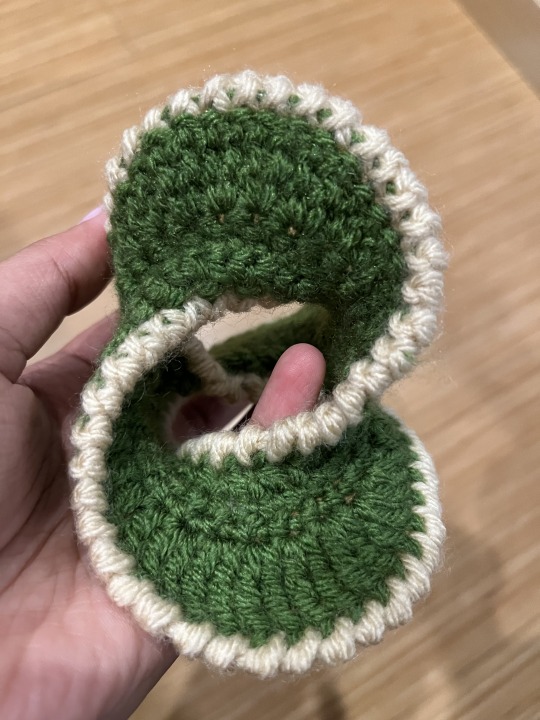

Made this as part of the online topological crochet course by Shiying Dong at the National Museum of Mathematics https://www.instagram.com/momath1/?hl=en.
34 notes
·
View notes
Text
Ernesto Neto
Ernesto Neto
Born 1964
Ernesto was raised in Rio De Janeiro and attended the Escola de Artes. His first solo exhibition was at Petit Galerie in 1988. He became known is Brazil having two exhibitions Sao Paulo and Sergio Porto and in 1996 had his first international exhibitions in Chicago, California and Madrid.
Ernesto is a contemporary visual artist who is inspired by the Brazilian Neo-concretism movement of the 1950’s.
He works in large scale abstraction and his work fills entire inside spaces and encourages the viewer to participate in the artwork by having a kinaesthetic experience. He mainly uses white stocking and Styrofoam material infused with aromatics.
Initially he was going to train as an astronomer but was allured by the sensorial awareness of art.
He learned to crochet from his grandmother and sees it not just as aesthetics but as intimate.
His Renowned Work:
Directions (displayed in Washington D.C.)
Four Artists and I (Butler Gallery, Kilkenny)
Anthropodino (Park Avenue Armory, New York)
Edges of the World (Hayward Gallery, London)
Dancing Allowed (Contemporary Arts Centre, Cincinnati)
From 1988-2014 he has been prolific in producing exhibitions especially in the years 2004, 2005 and 2012)
Context of His Work:
The Edges of the World is an immersive work which invokes social interaction in the partaker bringing Rio’s beaches to London. He invites people to walk barefoot and experience, to play, to lay down, to swim .. to be a child.
In this work focussing on beaches he wanted to be global, as beaches are, a conceptual land where one can sink into their consciousness and feel the relationship of human to environment, sensory awareness. He sees his work as a living organism.
In his artwork Circle-proto-temple, he creates a bright red space, cosy and comfortable dome like installation equipped with a circular lounge of red sofas and a red drum which pounds, it makes me conjure up an image of a beating heart or within a body.
He created a public oasis where city dwellers can slow down their manic rhythm of their daily routines and dive into calm waters as he says.
In the sensorial stimuli he wanted to create a universal language the universe and culture stating that everyone has the same personal care routine in the morning around the world. The cultural relationship is linked to the universal space of our bodies a kind of physical happening.
He explores the material sense of sculpture as a representation of nature and natural space like in Brazil nature and the built environment coexist. Although cultural the work is built with precise mathematics and topological contours.
How They Make Their Work: Their Process and Practice:
He uses transparent, stretchy material, Styrofoam pellets and pungent spices to create installations of soft, biomorphic sculptures.
He is considered by many to be a minimalist; however, he encourages our olfactory qualities to emerge.
He states that Rio is both beautiful, nature and urban and this kind of duality is life itself.
His work is a combination of ephemeral environments, knitted by men and assembled as art.
He states that in his generation there is an understanding of liberal leaning and he recognises the birth of liberalism in the mid 20th Century. He said he was inspired by Neo-concretism which altered the way the spectator interacted and enjoyed the art work.
Most of his work is site specific and he uses anything from crocheted nets/ cocoons, sewed nylon and the nets carry surprising substances that the partaker such as candles, sand, spices, lightweight balls. His nets create pendulums like rain fall. He takes threads to almost snapping point and shapes the piece.
He works with transparent materials, unusual textiles and considers both inside and outside of his sculpture identifying his work as nature rather than architecture.
He says to encounter your inner self in the work, the sensation that is not experienced by life itself.
0 notes
Text
Look and See – Math is Everywhere

by: Alec Gabrielle Gonzales and Andrea Trisha Buenaobra
Mathematics is present in everything in this world, and when I say everything there is no exemption. Even in breathing and sleeping, Mathematics is there. We might feel nauseous and problematic upon seeing mathematical formulas and equations, and deny the fact that math is in there.
Before I can fully convince you that Mathematics is present everywhere, let us define it first. According to Merriam-Webster Dictionary, Mathematics is the science of numbers and their operations, interrelations, combinations, generalizations, and abstractions and of space configurations and their structure, measurement, transformations, and generalizations; it is way beyond its branches namely algebra, arithmetic, calculus, geometry, and trigonometry. Basing in its definition, its scope is very vague and can touch all that exists.
Since it is visible and anchored in every field, it is very recognizable in the discipline of Humanities and Art. It has certain mathematical elements, concepts and equations present in each artwork. We may be second guessing in assessing this knowledge, but we must open our minds to the reality that Mathematics has a lot of contribution in all endeavors.
Let us point out how mathematics affects the music industry. Long ago, when classical music dominated the industry, it used much more complex notes and measurements compared to the pop culture we have today.
Fractions are used in music to indicate lengths of notes, and it also signifies the beat of a certain piece. In a musical piece, the time signature tells the musician information about the rhythm of the piece. There are also well-known mathematical relationships between the pitch of various notes on the musical keyboard. An octave is separated by a factor of two; a fifth interval (say C to G) by the ratio 3/2, and two adjacent notes on the keyboard are separated by the twelfth root of two = 1.059463.
A lot of great musicians are mathematicians. Albert Einstein is the greatest example; he can play violin and piano. According to his second wife, Elsa, he may be in a deep concentration at first, then playing the instrument later. The great Baroque composer, Johann Sebastian Bach whose specialty was canon, can be analyzed with the use of mobius strip. His compositions can be analyzed and can sound the same when played reversed or as the original. Bach’s work, Frère Jacques and Canon 3, have the same structure topologically: after the introductory measures, the canon settles into a cylindrical steady state. All of Bach's canons are organized this way.
Mobius strip is a spiritually significant symbol of balance and union. It is a 2-dimensional surface; has length and width but no thickness. It doesn’t only play a significant part in analyzing music, it is also present in the arts. In real life, it is bet portrayed in conveyor belts and bicycle chains, and it will last longer since all the surface areas get the same amount of rasp.
Math and dancing are also intricately linked. Sequence and power of set (or cardinal number) is observed in this activity to create a choreography. Sequence is an ordered list of objects, whereas the same elements can appear multiple times at different positions in the sequence; power of set (or cardinal number) is a finite set is a natural number which is the number of elements in the set. These elements are present in dancing since choreographers use sequential and repetitive steps to create a whole dance routine.
Geometry – with its shapes, patterns, angles and symmetry – is perhaps the most apparent field of mathematics present in dance. Looking at a solo dancer frozen in one position, we can see the lines of the body, their angles and directions in relation to each other and to the room. In a moving group of dancers, we notice the lines and shapes created by the ensemble, their change with the music, and the patterns of beats that cause those changes.
Mathematical concepts can be used to understand dance at a more profound level and to create better choreographies, and at the same time dance analogies can make math lessons more vivid and accessible for the students.
The connections of mathematics and visual arts are so many. For example, angles and perspective can be used to create dimensions inside the artwork; points, lines and shapes are used to produce an appealing artwork; and measurements are also applied to achieve the accurate size desired by the artist. It may not always be visible when we’re not looking closer and not open for the possibilities, but there is much symmetry, geometry, and measurement involved in creating beautiful art.
Its prominent connection started when the sculptor Plykleitos wrote his Canon, prescribing proportions based on the ratio 1:Ö2 for the ideal male nude back in the 4th BC. Persistent popular claims have been made for the use of the golden ratio in ancient art and architecture, without reliable evidence. This ratio is approximately 1.618 and can be achieved when you divide a line so that the longer part divided by the smaller part is equal to the actual whole line divided by the longer part. It is also represented in represented by the Greek letter phi.
Artists also apply different techniques in doing their artworks; these techniques serve as their “signature” or as a trademark. Mathematics is still present in the picture. For example, the famous Pablo Picasso pioneered the cubism, that is characterized by the use of geometric planes and shapes.
A perfect example is the well-known work of Leonardo da Vinci, Mona Lisa. When looked closely, it has numbers put inside the painting itself. The golden ratio (1.618) is also noticeable when we measure the appendages of the subject. It is considered as a perfect artwork.
Another example is tessellations, the work of the Dutch graphic artist M. C. Escher and mathematician Sir Roger Penrose who brought attention to the concept. A tessellation is a pattern of shapes that fit together perfectly and repeat in patterns. It may not seem like it has anything to do with math, but it is all about math as they can be tiled to form a continuous pattern on an infinite plane.
Personally, I also think that the price of an artwork is another participation of Mathematics in visual arts. Since, money involves numbers and currency.
To sum up everything, Mathematics is also a study of patterns, and we can study everything in arts and humanities from different mathematical perspectives, including geometry, number theory, trigonometry, differential calculus, and signal processing. As we can also observe, arts in all forms observe series of patterns for it to come up with an aesthetically pleasing output.
Mathematics is evidently related to Architecture. The concept can even be considered null without it. Architecture is simply a whole other world of Math. This connection simply plays with numbers, measurements, shapes, proportions, perspectives, and everything in between. Architects use geometry to create outputs that are according to different principles such as aesthetic and mathematical.
Let’s go down to history lane. In ancient Egypt, Greece, India, and the Islamic world, the different buildings during that time, such as pyramids, tenokes, and palaces were made with specified proportions due to religious beliefs.In regards to architecture in the Islamic word, Math is used in geometric tiling patterns and shapes for the internal and external structure.
On the other hand, Renaissance architecture used symmetry and proportion as emphasized by known architects namely Andrea Palladio, Leon Battista Alberti, and Sebastian Serlio. They were influenced by De architectura of Vitruvius from ancient Rome. In addition, they were also influenced by Pythagoreans’ arithmetic.
Mathematics in weaving, or fiber arts is deeply inspired by a variety of mathematical concepts. Such creation includes quilts, knitting, cross-stitching, crochet, embroidery, and weaving. The mathematical concepts covered in this relation includes graph theory, number theory, topology, and algebra.
While this connection includes numerous techniques, some are naturally geometrical like the counted-thread embroidery. They also exemplify mathematical concepts through physical expression or visual utterance.
Media Arts and Mathematics go well with each other. Especially using media as an academe for the subject. The collaboration is very useful as it innovates and develops method of learning and teaching. Math can seem easier immersed with Media Arts as various means can be used. Aside from the helpful collaboration of both concepts in learning, you can also see Math in different forms of arts in media. For example, movies. The duration, special effects, and animations also involves Mathematics. It may not be salient in expression but it is evident especially in the process.
The combination of Math and Literature is significantly evident as it also gives us the reason why Math is important. Aside from that, there are also several reasons as to why they work well combined. Literature introduces the subject in a lighter approach and it also has specifications that triggers people’s interest with matter.
In addition, literature makes Math more interactive and less boring and traditional. This is very helpful especially with complicated problems and struggling audience. Examples would be books, they are written in a more understandable way in order to give a better learning process for the people especially complicated equations and problems.
References:
Bailey, D & Borwein, J. (2017, December 6). Why Are So Many Mathematicians Also Musicians? Retrieved in https://www.huffpost.com/entry/why-are-so-many-mathemati_b_9814796 on December 2019.
Phillips, T. (2016, November 25). Bach and the Musical Möbius Strip. Retrieved in https://plus.maths.org/content/topology-music-m-bius-strip on December 2019.
Wasilewska, K. (2012). Mathematics in the world of dance. Proceedings of Bridges 2012: Mathematics, Music, Art, Architecture, Culture, 453-456.
https://en.wikipedia.org/wiki/Mathematics_and_architecture
https://ourjourneywestward.com/math-and-literature-connection/
0 notes